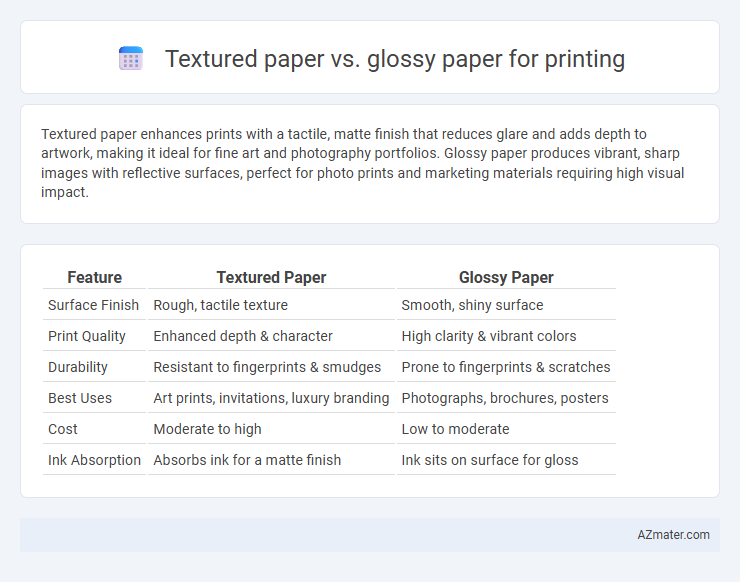Textured paper enhances prints with a tactile, matte finish that reduces glare and adds depth to artwork, making it ideal for fine art and photography portfolios. Glossy paper produces vibrant, sharp images with reflective surfaces, perfect for photo prints and marketing materials requiring high visual impact.
Table of Comparison
| Feature | Textured Paper | Glossy Paper |
|---|---|---|
| Surface Finish | Rough, tactile texture | Smooth, shiny surface |
| Print Quality | Enhanced depth & character | High clarity & vibrant colors |
| Durability | Resistant to fingerprints & smudges | Prone to fingerprints & scratches |
| Best Uses | Art prints, invitations, luxury branding | Photographs, brochures, posters |
| Cost | Moderate to high | Low to moderate |
| Ink Absorption | Absorbs ink for a matte finish | Ink sits on surface for gloss |
Introduction to Textured and Glossy Paper
Textured paper features a tactile surface with raised patterns or fibers, enhancing visual depth and providing a sophisticated, artistic appeal ideal for invitations and premium stationery. Glossy paper offers a smooth, shiny finish that intensifies color vibrancy and sharpness, making it a preferred choice for vibrant photographs and marketing materials. Choosing between textured and glossy paper depends on the desired aesthetic effect and functional requirements of the printed project.
Defining Textured Paper: Characteristics and Uses
Textured paper features a tactile surface with patterns such as linen, felt, or a rough finish, enhancing the sensory experience and visual appeal of printed materials. Commonly used for artistic prints, invitations, and stationery, its surface helps reduce glare and adds a handcrafted look. The unique texture improves ink absorption, making it ideal for watercolor prints and high-end business cards seeking a sophisticated, premium feel.
What is Glossy Paper? Key Features and Benefits
Glossy paper is a smooth, shiny surface material commonly used in photo printing and marketing materials to enhance color vibrancy and sharpness. Key features include a reflective coating that produces high contrast images, quick drying ink reception, and a durable finish resistant to smudging and fingerprints. Benefits of glossy paper involve producing visually striking prints with rich, vivid colors, making it ideal for brochures, posters, and high-quality photo prints.
Visual Appeal: Comparing Print Quality
Textured paper enhances print quality by adding depth and a tactile dimension, creating a sophisticated, artistic visual appeal that highlights intricate details and muted tones. Glossy paper intensifies color vibrancy and sharpness, providing a sleek, reflective surface that makes images appear more vivid and dynamic. Choosing between textured and glossy paper depends on the desired aesthetic, with textured paper suited for classic, elegant prints and glossy paper ideal for high-contrast, colorful images.
Touch and Feel: Tactile Experience Differences
Textured paper offers a distinct tactile experience with its raised patterns that enhance grip and create a sophisticated, artisanal feel, ideal for invitations and premium prints. Glossy paper provides a smooth, sleek surface that feels slick to the touch, emphasizing vibrant colors and sharp details but often feels less substantial or organic. The choice between textured and glossy paper significantly affects the sensory interaction, with textured paper inviting closer tactile engagement and glossy paper delivering a polished, modern finish.
Durability and Longevity Considerations
Textured paper offers enhanced durability due to its thicker fibers and resistance to scratches, making it ideal for prints requiring long-lasting quality. Glossy paper, while providing vibrant color reproduction, is more prone to fingerprints, smudges, and surface wear, which can reduce its longevity over time. For archival purposes or projects exposed to frequent handling, textured paper ensures better preservation and sustained visual appeal.
Cost Comparison: Textured vs Glossy Paper
Textured paper generally costs more than glossy paper due to its specialized manufacturing process and added tactile appeal, making it a premium choice for high-end prints. Glossy paper is typically less expensive and more widely available, offering vibrant color reproduction ideal for mass printing. When budgeting for print projects, textured paper increases upfront costs but can add perceived value, while glossy paper remains a cost-effective option for volume and brightness.
Best Applications: When to Use Each Type
Textured paper excels for artistic prints, invitations, and stationery where tactile feel and a sophisticated look enhance the experience, making it ideal for elegant or vintage designs. Glossy paper is best suited for vibrant photo printing, marketing materials, and brochures that require sharp image clarity and vivid colors to capture attention. Choosing textured paper adds depth and character, while glossy paper delivers high contrast and sheen for impactful visual presentations.
Environmental Impact and Sustainability
Textured paper often uses fewer chemical coatings and has a lower environmental footprint compared to glossy paper, which requires plastic-based coatings that hinder recyclability. Glossy paper's production consumes more energy and releases more volatile organic compounds (VOCs), contributing to environmental pollution. Choosing recycled textured paper improves sustainability by reducing deforestation and waste, whereas glossy paper typically complicates recycling due to its non-biodegradable finish.
Choosing the Right Paper for Your Printing Needs
Textured paper offers a tactile, elegant finish ideal for invitations, business cards, and artistic prints, enhancing visual depth and sophistication in your project. Glossy paper provides vibrant color reproduction and sharp detail, making it perfect for photos, brochures, and marketing materials that require high-impact visuals. Selecting the right paper depends on your desired aesthetic and functionality, with textured paper favoring a classic, professional feel and glossy paper emphasizing brightness and contrast.

Infographic: Textured paper vs Glossy paper for Printing
 azmater.com
azmater.com